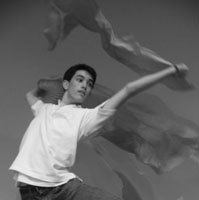Fringe Shorts: Press Play
Lightsey Darst saw "Press Play," and this final Fringe Shorts review wraps up on a hopeful note: even if we didn't get everything right this time, there's more times. Youth is not wasted on the young.

“Press Play,”
choreography by Ben Kimitch, at the Southern Theater
It’s interesting to see what inspires a young artist. At nineteen, to judge by his show “Press Play,” Ben Kimitch loves ballet, Chinese dance, and romantic music; he’s caught up in their beauty, whimsy, and symbolic expression of various scenarios (one piece is described with “In the midst of a rising sun reflected on the rippling water, a calm ocean slowly awakens”).
I may have spent too much time working next to Macalester College, but this strikes me as an unusual bundle of interests for a young artist—no politics, no sex, no angst. It’s too early to tell whether unusual means good, but right now it certainly amounts to audience approval. “Press Play” is very pretty, like a combination garden and candy store, all peonies and Turkish delight. Add to this the confident charm of musical theater teens (all the performers are under twenty-one) and you have some idea of the insouciant appeal of “Press Play”—which so overcame one man that he shouted “Yeah!” after a piece featuring dawn-colored silk and pointe shoes.
Kimitch’s technical skills are impressive. He moves dancers around stage well, particularly in solos and duets (his larger groups feel more formal). His “Sword Meditation” is particularly successful in sliding the two dancers in and out of unison and in using all areas of the stage. He’s sensitive to music and keen to give you lovely visuals. He’s modest about casting himself—unnecessarily so, given his silk-limbed coordination. However, the other dancers also show promise, particularly Matt Dittes, Eve Schulte, and Michelle Messer.
I’m struggling with how to say this without sounding condescending: it’s no shame for a young artist not to know what he or she is talking about. That neither Kimitch nor his dancers understand the emotions of a woman who “drowns herself in a river, uniting with the waves so she may live a new life with the rhythm of the water” may be less important than that Kimitch can imagine such a scenario. Eventually he will learn more about the emotional life, and then he will have to figure out how to connect his art to that storm and source.